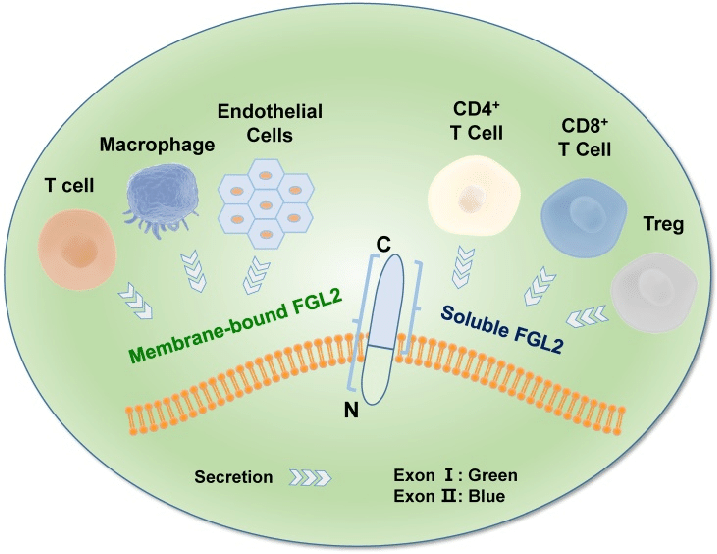Inflammation is a series of complex response events produced by the host system to pathogen infection and various tissue injuries. When the inflammatory response continues, it enters the stage of “uncontrollable inflammation”, which plays an important role in the occurrence and development of complex diseases such as tumors. Therefore, the key molecular events in the process of “inflammation-tumor” are of vital significance to the mechanism and prevention of tumors.
As a protein molecule related to chronic inflammation and immune injury, FGL2 can also promote the occurrence and development of tumors. It belongs to a member of the fibrinogen superfamily, its gene consists of two exons and one intron, and the encoded protein is 432 and 439 amino acids in length in mice and humans, respectively. According to the analysis of its structure and sequence, the encoded protein is mainly composed of N-terminal domain and carboxy terminus. It is predicted that the N-terminal domain α-helix and several serine residues can form a coiled-coil structure; the carboxy-terminal is composed of 229 amino acids and contains a highly conserved spherical domain-FRED. FGL2 knockout mice grow and develop normally. This meaning that FGL2 expression level in normal individuals is extremely low.
Figure 1. Molecular structure of FGL2.
The cellular location and expression of FGL2 are closely related to its function. In macrophages and endothelial cells, it is mainly expressed on the cell membrane in the form of a transmodel, showing a pro-immunocoagulant function-directly converting prothrombin into thrombin. The immune coagulation function of FGL2 plays a key role in aggravating lesion-promoting injury in human and animal disease models such as viral hepatitis, xenograft allograft immune rejection, and fetal loss syndrome. In regulatory T cells such as CD4 + CD25 + Foxp3 +, FGL2 mainly appears in the secreted form. It can inhibit DC differentiation and antigen presentation, induce B cell apoptosis, inhibit effector T cell proliferation, and play an immunosuppressive role. Its carboxy-terminal FRED is the functional domain of its immunosuppressive activity. Secreted FGL2 is also involved in the pathogenesis of allograft rejection, autoimmune diseases, HIV, SARS and HBV infection.
FGL2 and disease
Studies have found that FGL2 is highly expressed in microvascular endothelial cells, causing microcirculatory disturbance, promoting myocardial and liver ischemia-reperfusion injury, arthritis, type 2 diabetic heart failure, and type 2 diabetic nephropathy; FGL2 is highly expressed in inflammatory bowel disease mucosa , correlated with disease severity; in HCV, NAFLD, acute pancreatitis, and acute pancreatitis-induced liver injury, increased serum sFGL2 levels correlated with disease severity; in acute rejection of kidney transplantation, TNFx and INF-y stimulated the JNK pathway Mediates the secretion of sFGL2 by CD4 + T cells, causing the apoptosis of renal tubular epithelial cells and aggravating the disease; the increase of serum sFGL2 promotes the progression of systemic sclerosis; the increase of sFGI2 and its receptor FeyIIB protects against ischemia-reperfusion injury after renal transplantation; In MHV-3-induced fulminant hepatitis in mice, knockout of TNFR can reduce the expression of sFGL2 and mFGI2 and improve the condition; mucous membrane CD8+aa+ in inflammatory bowel disease and organ transplantation DNT all express a large amount of sFGL2.
In summary, FGL2 is one of the key molecules in the process of inflammation and tumorigenesis, which provides a new entry point for early clinical diagnosis and targeted therapy.

